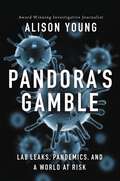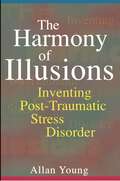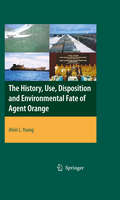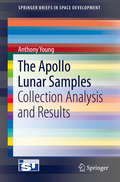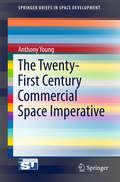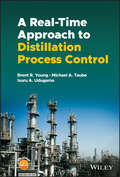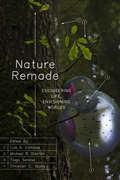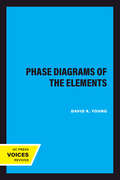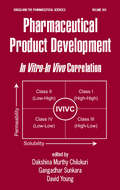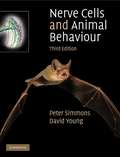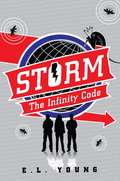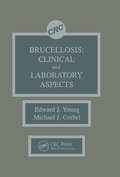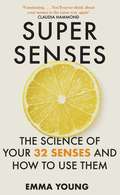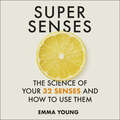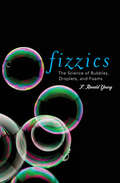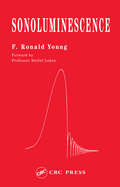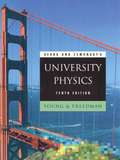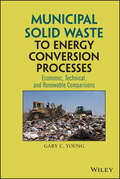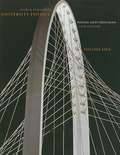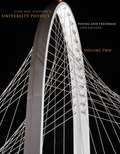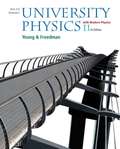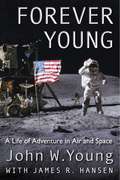- Table View
- List View
Pandora's Gamble: Lab Leaks, Pandemics, and a World at Risk
by Alison YoungNamed to Kirkus Reviews&’ Best Books of 2023 A &‘remarkable book.&’ – The New York TimesThis fearless, deeply reported book about laboratory accidents asks the haunting question some elite scientists don&’t want the public to entertain: Did the COVID-19 pandemic start with a lab leak in Wuhan, China? This is an obvious question. Yet there&’s been an extraordinary effort by government officials in China, as well as leading scientific experts in the United States and around the world, to shut down any investigation or discussion of the lab leak theory. In private, however, some of the world&’s elite scientists have seen a lab accident as a very real and horrifying possibility. They know what the public doesn&’t. Lab accidents happen with shocking frequency. Even at the world&’s best-run labs. That&’s among the revelations from Alison Young, the award-winning investigative reporter who has spent nearly 15 years uncovering shocking safety breaches at prestigious U.S. laboratories for USA Today and other respected news outlets. In Pandora&’s Gamble, Young goes deep into the troubling history -- and enormous risks -- of leaks and accidents at scientific labs. She takes readers on a riveting journey around the world to some of the worst lab mishaps in history, including the largely unknown stories of the lab workers at the U.S. Army&’s Camp Detrick who suffered devastating infections at alarming rates during World War II. And her groundbreaking reporting exposes for the first time disturbing new details about recent accidents at prestigious laboratories – and the alarming gaps in government oversight that put all of us at risk. Sourced through meticulous reporting and exclusive interviews with key players including Dr. Anthony Fauci, former CDC Director Tom Frieden and others, Young&’s examination reveals that the only thing rare about lab accidents is the public rarely finds out about them. Because when accidents happen, powerful people and institutions often work hard to keep the information secret.
The Harmony of Illusions: Inventing Post-Traumatic Stress Disorder
by Allan YoungAs far back as we know, there have been individuals incapacitated by memories that have filled them with sadness and remorse, fright and horror, or a sense of irreparable loss. Only recently, however, have people tormented with such recollections been diagnosed as suffering from "post-traumatic stress disorder." Here Allan Young traces this malady, particularly as it is suffered by Vietnam veterans, to its beginnings in the emergence of ideas about the unconscious mind and to earlier manifestations of traumatic memory like shell shock or traumatic hysteria. In Young's view, PTSD is not a timeless or universal phenomenon newly discovered. Rather, it is a "harmony of illusions," a cultural product gradually put together by the practices, technologies, and narratives with which it is diagnosed, studied, and treated and by the various interests, institutions, and moral arguments mobilizing these efforts. This book is part history and part ethnography, and it includes a detailed account of everyday life in the treatment of Vietnam veterans with PTSD. To illustrate his points, Young presents a number of fascinating transcripts of the group therapy and diagnostic sessions that he observed firsthand over a period of two years. Through his comments and the transcripts themselves, the reader becomes familiar with the individual hospital personnel and clients and their struggle to make sense of life after a tragic war. One observes that everyone on the unit is heavily invested in the PTSD diagnosis: boundaries between therapist and patient are as unclear as were the distinctions between victim and victimizer in the jungles of Southeast Asia.
The History, Use, Disposition and Environmental Fate of Agent Orange
by Alvin Lee YoungFor almost four decades, controversy has surrounded the tactical use of herbicides in Southeast Asia by the United States military. Few environmental or occupational health issues have received the sustained international attention that has been focused on Agent Orange, the major tactical herbicide deployed in Southern Vietnam. With the opening and establishment of normal relations between the United States and the Socialist Republic of Vietnam in 1995, the time has come for a thorough re-examination of the military use of Agent Orange and other "tactical herbicides" in Southern Vietnam, and the subsequent actions that have been taking place since their use in Vietnam. The United States Department of Defense has had the major role in all military operations involving the use of tactical herbicides, including that of Agent Orange. This included the Department's purchase, shipment and tactical use of herbicides in Vietnam, its role in the disposition of Agent Orange after Vietnam, its role in conducting long-term epidemiological investigations of the men of Operation RANCH HAND, and its sponsorship of ecological and environmental fate studies. This book was commissioned by The Office of the Deputy Under Secretary of Defense (Installations and Environment) with the intent of providing documentation of the knowledge on the history, use, disposition and environmental fate of Agent Orange and its associated dioxin.
The Apollo Lunar Samples
by Anthony Young"The Apollo Lunar Samples" focuses on the specific mission planning for lunar sample collection, the equipment used, and the analysis and findings concerning the samples at the Lunar Receiving Laboratory in Texas. In this book, Anthony Young documents the collection of Apollo samples for the first time for readers of all backgrounds, and includes interviews with many of those involved in planning and analyzing the samples. NASA contracted with the U. S. Geologic Survey to perform classroom and field training of the Apollo astronauts. NASA's Geology Group within the Manned Spacecraft Center in Houston, Texas, helped to establish the goals of sample collection, as well as the design of sample collection tools, bags, and storage containers. In this book, detailed descriptions are given on the design of the lunar sampling tools, the Modular Experiment Transporter used on Apollo 14, and the specific areas of the Lunar Rover vehicle used for the Apollo 15, 16, and 17 missions, which carried the sampling tools, bags, and other related equipment used in sample collection. The Lunar Receiving Laboratory, which was designed and built at the Manned Spacecraft Center in Texas for analysis and storage of the lunar samples returned from the Apollo lunar landing missions is also described in detail. There are also descriptions of astronaut mission training for sample collecting, with the focus on the specific portions of the mission EVAs devoted to this activity.
The Twenty-First Century Commercial Space Imperative
by Anthony YoungYoung addresses the impressive expansion across existing and developing commercial space business markets, with multiple private companies competing in the payload launch services sector. The author pinpoints the new markets, technologies, and players in the industry, as well as highlighting the overall reasons why it is important for us to develop space. NASA now relies on commercial partners to supply cargo and crew spacecraft and services to and from the International Space Station. The sizes of satellites are diminishing and their capabilities expanding, while costs to orbit are decreasing. Suborbital space tourism holds the potential of new industries and jobs. Commercial space exploration of the Moon and the planets also holds promise. All this activity is a catalyst for anyone interested in joining the developing space industry, from students and researchers to engineers and entrepreneurs. As more and more satellites and rockets are launched and the business of space is expanding at a significant pace, it is increasingly important for scientists and engineers of many disciplines to understand how the business evolved and where it is continuing to develop. The growing field is fully explored in this concise overview to the players in this changing landscape.
A Real-time Approach to Distillation Process Control
by Brent R. Young Michael A. Taube Isuru A. UdugamaA Real-Time Approach to Distillation Process Control A practical and hands-on discussion of modern distillation control In A Real-time Approach to Distillation Process Control, a team of distinguished researchers and industrial practitioners delivers a practical text combining hands-on and active learning using process simulation with discussions of the fundamental knowledge and tools required to apply modern distillation control principles. The book offers a balanced, real-time approach integrated with practical insights. It includes many exercises designed to be simulator agnostic that can be performed on the process simulator locally available to the reader. Readers will discover explorations of topics including distillation control hardware, distillation composition control, refinery versus chemical plant distillation control, distillation control tuning, advanced regulatory control, and more. They’ll also find: A thorough introduction to distillation fundamentals, as well as basic and advanced modern controls from a practical point of view Comprehensive explorations of known base controls combined with modern control practices Practical discussions of hands-on modelling and simulation exercises, allowing the reader to design and tune controls on a distillation column Fulsome treatments of control structure design integrated with controller tuning using a real-time approach Perfect for senior undergraduate and graduate students studying general process control or distillation process control, A Real-time Approach to Distillation Process Control will also benefit plant managers, production supervisors, startup supervisors, operations engineers, production engineers, and chemical engineers working in industry.
Nature Remade: Engineering Life, Envisioning Worlds (Convening Science: Discovery at the Marine Biological Laboratory)
by Christian C. Young“Engineering” has firmly taken root in the entangled bank of biology even as proposals to remake the living world have sent tendrils in every direction, and at every scale. Nature Remade explores these complex prospects from a resolutely historical approach, tracing cases across the decades of the long twentieth century. These essays span the many levels at which life has been engineered: molecule, cell, organism, population, ecosystem, and planet. From the cloning of agricultural crops and the artificial feeding of silkworms to biomimicry, genetic engineering, and terraforming, Nature Remade affirms the centrality of engineering in its various forms for understanding and imagining modern life. Organized around three themes—control and reproduction, knowing as making, and envisioning—the chapters in Nature Remade chart different means, scales, and consequences of intervening and reimagining nature.
Nature Remade: Engineering Life, Envisioning Worlds (Convening Science: Discovery at the Marine Biological Laboratory)
by Christian C. Young“Engineering” has firmly taken root in the entangled bank of biology even as proposals to remake the living world have sent tendrils in every direction, and at every scale. Nature Remade explores these complex prospects from a resolutely historical approach, tracing cases across the decades of the long twentieth century. These essays span the many levels at which life has been engineered: molecule, cell, organism, population, ecosystem, and planet. From the cloning of agricultural crops and the artificial feeding of silkworms to biomimicry, genetic engineering, and terraforming, Nature Remade affirms the centrality of engineering in its various forms for understanding and imagining modern life. Organized around three themes—control and reproduction, knowing as making, and envisioning—the chapters in Nature Remade chart different means, scales, and consequences of intervening and reimagining nature.
Nature Remade: Engineering Life, Envisioning Worlds (Convening Science: Discovery at the Marine Biological Laboratory)
by Christian C. Young“Engineering” has firmly taken root in the entangled bank of biology even as proposals to remake the living world have sent tendrils in every direction, and at every scale. Nature Remade explores these complex prospects from a resolutely historical approach, tracing cases across the decades of the long twentieth century. These essays span the many levels at which life has been engineered: molecule, cell, organism, population, ecosystem, and planet. From the cloning of agricultural crops and the artificial feeding of silkworms to biomimicry, genetic engineering, and terraforming, Nature Remade affirms the centrality of engineering in its various forms for understanding and imagining modern life. Organized around three themes—control and reproduction, knowing as making, and envisioning—the chapters in Nature Remade chart different means, scales, and consequences of intervening and reimagining nature.
Phase Diagrams of the Elements
by David A. YoungThe behavior of solid and liquid matter at high pressures and temperatures is best described in a phase diagram, which shows the regions of stability of different phases of the material. Thanks to the diamond-anvil cell, which has made possible much higher pressures, and to new and very accurate theoretical models and methods, Phase Diagrams of the Elements presents the most up-to-date information on the phase behavior of all the chemical elements from hydrogen to fermium.The book summarizes, with the aid of tables and illustrations, the experimental data and the theoretical calculations. Each element is discussed in a separate section. Other chapters deal with methods, the liquid-vapor transition, and an overview of the elements. While comprehensively reviewing all that has been done in this important area, the author also points to questions that need much more experimental and theoretical work.
Pharmaceutical Product Development: In Vitro-In Vivo Correlation (Drugs And The Pharmaceutical Sciences Ser. #Vol. 165)
by David Young Chilukuri Dakshina Murthy Gangadhar SunkaraDuring the last two decades, the pharmaceutical industry has been under pressure to reduce development costs and the time needed to bring drugs to market in order to maximize return on investment and bring treatments to patients sooner. To meet these ends, pharmaceutical scientists working in the differing areas of pharmacy, pharmaceutics, and phar
Nerve Cells and Animal Behaviour
by David Young Peter SimmonsAn extensively revised third edition of this introduction to neuroethology - the neuronal basis of animal behaviour - for zoology, biology and psychology undergraduate students. The book focuses on the roles of individual nerve cells in behaviour, from simple startle responses to complex behaviours such as route learning by rats and singing by crickets and birds. It begins by examining the relationship between brains and behaviour, and showing how study of specialised behaviours reveals neuronal mechanisms that control behaviour. Information processing by nerve cells is introduced using specific examples, and the establishing roles of neurons in behaviour is described for a predator-prey interaction, toads versus cockroaches. New material includes: vision by insects, which describes sensory filtering; hunting by owls and bats, which describes sensory maps; and rhythmical movements including swimming and flying, which describes how sequences of movements are generated. Includes stunning photographs which capture the detail of the behaviour.
Storm: The Infinity Code
by E. L. YoungSTORM is a gadget-packed, high-adrenaline adventure-and also the name of a dynamic organization formed by three brainiac kids: WILL: loner, inventive genius, and creator of cutting-edge gear- STORM'S resident skeptic ANDREW: software whiz-kid and millionaire-STORM's founder, financial backer, and fashion disaster GAIA: brilliant and mysterious chemist-fluent in French, Italian, Mandarin, and blowing stuff up AT FIRST, Will scoffs at STORM's grand plans to combat global strife. But when the group uncovers a plot to create a deadly, revolutionary weapon, Will is forced to swallow his doubts-and fast. He, Gaia, and Andrew must race from London to St. Petersburg to find and dismantle the weapon, and confront the psychopathic scientist behind it all. But there's more to this wicked plot than meets the eye. Whether STORM is up to the task or not, one thing's for sure-their lives are never going to be the same.
Brucellosis: Clinical and Laboratory Aspects
by Edward J. Young Michael J. CorbelFourteen brucellosis experts from seven countries discuss the history, epidemiology, microbiology, immunology, diagnosis, treatment, and control of brucellosis in animals and man. Edited by members of the World Health Organization's Expert Committee on Brucellosis, this text is the first comprehensive treatment of the disease since The Nature of Brucellosis by Wesley W. Spink in 1956. Topics reviewed with current references include infection caused by newer species of Brucella, such as B. canis, newer diagnostic techniques, such as radioimmunoassay and ELISA, and newer treatments, such as rifampin and the quinolones. The pathogenesis and pathophysiology of brucellosis is reviewed in depth, correlating the disease in animals with the illness in humans. This volume is extremely useful for clinicians, researchers, and students in medicine, veterinary science, microbiology, immunology, epidemiology, public health, and international health.
Super Senses: The Science of Your 32 Senses and How to Use Them
by Emma YoungHow do you sniff out danger? What is a sense of direction or a gut instinct? You know about your five senses: hearing, sight, smell, taste and touch. But recent research has shown that we actually have at least thirty-two. We take our senses for granted but what would be possible if we properly understood how they all work? Award-winning science writer Emma Young has spent over a decade finding out, and in Super Senses she takes us on an exhilarating sensory journey, revealing how we taste things without using our tongues, why swearing is good for us and why both chocolate and rollercoasters can help you fall in love.Using the very latest cutting-edge research, she explains the exploits of record-breaking freedivers, whirling dervishes, super-tasters, stock market millionaires, and many more. Discover how touch can ease pain, how taking your pulse can make you fitter and why Abba's Dancing Queen sounds different in Bolivia. Sharing surprising secrets from blind ballerinas, voodoo priests and even a nurse who can smell Parkinson's disease before it is diagnosed, Super Senses uncovers the science behind these abilities that make us human - and offers fascinating lessons in how we can all learn to use them better. Could being more sensitive make us happier, healthier - or even wealthier?
Super Senses: The Science of Your 32 Senses and How to Use Them
by Emma YoungA mind-bending, eye-opening scientific exploration of our senses - all 32 of them.How do you sniff out danger? What is a sense of direction or a gut instinct? You know about your five senses: hearing, sight, smell, taste and touch. But recent research has shown that we actually have at least thirty-two. We take our senses for granted but what would be possible if we properly understood how they all work? Award-winning science writer Emma Young has spent over a decade finding out, and in Super Senses she takes us on an exhilarating sensory journey, revealing how we taste things without using our tongues, why swearing is good for us and why both chocolate and rollercoasters can help you fall in love.Using the very latest cutting-edge research, she explains the exploits of record-breaking freedivers, whirling dervishes, super-tasters, stock market millionaires, and many more. Discover how touch can ease pain, how taking your pulse can make you fitter and why Abba's Dancing Queen sounds different in Bolivia. Sharing surprising secrets from blind ballerinas, voodoo priests and even a nurse who can smell Parkinson's disease before it is diagnosed, Super Senses uncovers the science behind these abilities that make us human - and offers fascinating lessons in how we can all learn to use them better. Could being more sensitive make us happier, healthier - or even wealthier?(P) 2021 Hodder & Stoughton Ltd
Fizzics: The Science of Bubbles, Droplets, and Foams
by F. Ronald YoungBubbles are everywhere—in water and in air, made from soap and from gas. They are referenced in literature and sung about in songs. They are even the subject of great works of art. From the youngest child blowing bubbles in the backyard to the adult studying the fascinating science behind them, bubbles capture our imagination. F. Ronald Young’s far-reaching survey of the humble bubble explores the complex behavior of these seemingly simple objects. If you stop to think about it, bubbles and droplets are the cornerstones of the world around us. They are the reason that dolphins cannot swim faster, that the sky is blue, and that coffee rings form. They are essential to knowing how atom smashers work, how detergents clean dishes, and how to pour a perfect pint.Beyond these basics, Young shows how humans have put bubbles to use throughout history. Whether in technology—making fire-fighting foams and waterproof makeup—or in medicine—cleaning wounds and clarifying ultrasounds—bubbles are capable of more than most of us have imagined. With easy-to-understand explanations, detailed illustrations, and entertaining anecdotes, Young reveals the Fizzics behind these familiar—yet surprising—objects.
Sonoluminescence
by F. Ronald YoungWhile it is still a mystery of how a low-energy-density sound wave can concentrate enough energy in a small enough volume to cause the emission of light, research in acoustic cavitation and sonoluminescence has lead to plausible theories in which the source of light can be experimentally sustained. It has also lead to promising applications, such a
University Physics (Tenth Edition)
by Young Roger A. Freedman T. R. Sandin A. Lewis FordNow in its commemorative Tenth Edition, this book remains a classic. Adhering to the highest standards of integrity and incorporating some of the findings of current research in physics, it enables readers to develop physical intuition and build strong problem-solving skills. It also points out conceptual and computational pitfalls that commonly plague beginning physics students and provides them with explicit strategies for analyzing physical situations and solving problems.
Municipal Solid Waste to Energy Conversion Processes
by Gary C. YoungA technical and economic review of emerging waste disposal technologies Intended for a wide audience ranging from engineers and academics to decision-makers in both the public and private sectors, Municipal Solid Waste to Energy Conversion Processes: Economic, Technical, and Renewable Comparisons reviews the current state of the solid waste disposal industry. It details how the proven plasma gasification technology can be used to manage Municipal Solid Waste (MSW) and to generate energy and revenues for local communities in an environmentally safe manner with essentially no wastes. Beginning with an introduction to pyrolysis/gasification and combustion technologies, the book provides many case studies on various waste-to-energy (WTE) technologies and creates an economic and technical baseline from which all current and emerging WTE technologies could be compared and evaluated. Topics include: Pyrolysis/gasification technology, the most suitable and economically viable approach for the management of wastes Combustion technology Other renewable energy resources including wind and hydroelectric energy Plasma economics Cash flows as a revenue source for waste solids-to-energy management Plant operations, with an independent case study of Eco-Valley plant in Utashinai, Japan Extensive case studies of garbage to liquid fuels, wastes to electricity, and wastes to power ethanol plants illustrate how currently generated MSW and past wastes in landfills can be processed with proven plasma gasification technology to eliminate air and water pollution from landfills.
University Physics (Volume 1) (13th Edition)
by Hugh D. Young Roger A. FreedmanUniversity Physics with Modern Physics, continues to set the benchmark for clarity and rigor combined with effective teaching and research-based innovation. University Physics is known for its uniquely broad, deep, and thoughtful set of worked examples--key tools for developing both physical understanding and problem-solving skills. The Thirteenth Edition revises all the Examples and Problem-Solving Strategies to be more concise and direct while maintaining the Twelfth Edition's consistent, structured approach and strong focus on modeling as well as math. To help students tackle challenging as well as routine problems, the Thirteenth Edition adds Bridging Problems to each chapter, which pose a difficult, multiconcept problem and provide a skeleton solution guide in the form of questions and hints. The text's rich problem sets--developed and refined over six decades--are upgraded to include larger numbers of problems that are biomedically oriented or require calculus. The problem-set revision is driven by detailed student-performance data gathered nationally through MasteringPhysics®, making it possible to fine-tune the reliability, effectiveness, and difficulty of individual problems. Complementing the clear and accessible text, the figures use a simple graphic style that focuses on the physics. They also incorporate explanatory annotations--a technique demonstrated to enhance learning. The above ISBN is just for the standalone book only Chapters 1-20, if you want the Book(only Chapters 1-20/Access Code please order: ISBN: 0321785916 / 9780321785916 University Physics Volume 1(Chapters 1-20 only ) and MasteringPhysics® with Pearson eText Student Access Code Card Package consists of: 032173338X / 9780321733382 University Physics Volume 1 (Chs. 1-20 only) 0321741269 / 9780321741264 MasteringPhysics® with Pearson eText Student Access Code Card for University Physics If you want the complete book order ISBN 0321696867 9780321696861 University Physics with Modern Physics, 13/e -- or valuepack 0321675460 / 9780321675460 University Physics with Modern Physics with MasteringPhysics® Package consists of 0321696867 / 9780321696861 University Physics with Modern Physics(complete book) 0321741269 / 9780321741264 MasteringPhysics® with Pearson eText Student Access Code Card for University Physics (ME component )
Sears and Zemansky's: University Physics, Volume 2
by Hugh D. Young Roger A. Freedman A. Lewis FordUniversity Physics Volume 2 (Chapers 21-37), 13/e continues to set the benchmark for clarity and rigor combined with effective teaching and research-based innovation. University Physics is known for its uniquely broad, deep, and thoughtful set of worked examples-key tools for developing both physical understanding and problem-solving skills. The Thirteenth Edition revises all the Examples and Problem-Solving Strategies to be more concise and direct while maintaining the Twelfth Edition's consistent, structured approach and strong focus on modeling as well as math. To help students tackle challenging as well as routine problems, the Thirteenth Edition adds Bridging Problems to each chapter, which pose a difficult, multiconcept problem and provide a skeleton solution guide in the form of questions and hints. The text's rich problem sets-developed and refined over six decades-are upgraded to include larger numbers of problems that are biomedically oriented or require calculus. The problem-set revision is driven by detailed student-performance data gathered nationally through MasteringPhysics®, making it possible to fine-tune the reliability, effectiveness, and difficulty of individual problems.
Sears and Zemansky's University Physics: with Modern Physics, 11th Edition
by Hugh D. Young Roger A. Freedman A. Lewis FordThis book is the product of more than half a century of innovation in physics education. When the first edition of University Physics by Francis W. Sears and Mark W. Zemansky appeared in 1949, it was revolutionary among calculus-based physics textbooks in its emphasis on the fundamental principles of physics and how to apply them. The success of University Physics with generations of students and educators throughout the world is a testament to the merits of this approach. In preparing this new Eleventh Edition, we have further enhanced and developed University Physics to emphasize two key objectives: helping students develop conceptual understanding, and helping them build strong problem- solving skills.
University Physics: Technology Update, Volume 2
by Hugh D. Young Roger A. Freedman A. Lewis FordUniversity Physics with Modern Physics, Technology Update, Thirteenth Edition continues to set the benchmark for clarity and rigor combined with effective teaching and research-based innovation. Volume 2 is Chapters 21 to 37.
Forever Young: A Life of Adventure in Air and Space
by John W YoungHe walked on the Moon. He flew six space missions in three different programs--more than any other human. He served with NASA for more than four decades. His peers called him the "astronaut's astronaut."Enthusiasts of space exploration have long waited for John Young to tell the story of his two Gemini flights, his two Apollo missions, the first-ever Space Shuttle flight, and the first Spacelab mission. Forever Young delivers all that and more: Young's personal journey from engineering graduate to fighter pilot, to test pilot, to astronaut, to high NASA official, to clear-headed predictor of the fate of Planet Earth.Young, with the assistance of internationally distinguished aerospace historian James Hansen, recounts the great episodes of his amazing flying career in fascinating detail and with wry humor. He portrays astronauts as ordinary human beings and NASA as an institution with the same ups and downs as other major bureaucracies. He frankly discusses the risks of space travel, including what went wrong with the Challenger and Columbia shuttles. Forever Young is one of the last memoirs produced by an early American astronaut. It is the first memoir written by a chief of the NASA astronaut corps. Young's experiences and candor make this book indispensable to everyone interested in the U.S. space program.
